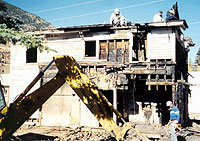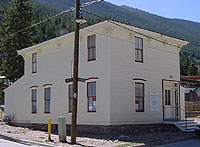Grant News
Burned Out Building Rises from the Ashes
Early on January 22, 1974, a faulty electrical wire sparked a fire that almost destroyed the historic Mahany Building on Sixth and Taos streets in Georgetown. Volunteer firemen, handicapped by extreme cold, battled the blaze for two hours. Despite their best efforts, authorities pronounced the building dead-a "total loss"-by midmorning.
The building remained vacant for twenty-six years after the fire. Locals referred to the blackened eyesore as the "burned out building," or "BOB" for short. Most people thought that the house, which blighted Georgetown's otherwise vibrant commercial district, should be demolished.
Historic Georgetown, Inc. (HGI), a local preservation group, disagreed with the conventional wisdom. Undaunted by naysayers, they declared that the Mahany Building should be restored. Of course the history-minded organization could call upon the wisdom of hindsight. They knew that the former miner's residence, built in 1869-1870, could once again contribute to Georgetown's architectural character. Two stories high with Italianate architectural elements, it is one of the five oldest buildings in Georgetown and one of the town's few remaining wood commercial structures.
HGI also understood that volunteer firefighters had saved the town from total destruction more than once. Therefore, restoring the burned out building would not only preserve an important part of the town's architectural history, but repay a debt owed to volunteer firemen who, over the past century and more, ensured Georgetown's reputation as a Victorian showplace.
If not for these unpaid heroes, Georgetown might have shared Central City's fate. Fire gutted its business district once in 1874, and twice in 1896. Fortunately, Georgetown's leaders recognized the danger early and made continual investments in fire stations and fire suppression equipment. They established the first volunteer fire department in 1869 and built a fire hydrant system in 1874. The investment paid off. Prompt response by volunteers usually prevented fires from spreading to adjacent structures, even though most buildings were built entirely of wood. An exception occurred in 1899 when someone tried to thaw frozen pipes in the McClellan Opera House by starting a small fire. The fire blazed out of control, damaging a few adjacent buildings, including the American House hotel. Overcoming problems with frozen hoses, firemen eventually extinguished the fire and saved the nearby Hotel de Paris and other notable buildings. Today, the Hotel de Paris is a museum and Georgetown landmark.
Aided by a $195,000 State Historical Fund grant, HGI acquired the burned out building in 1999 and began restoring it a year later. After stabilizing the structure, contractors restored the home's interior and exterior. Workers repaired historic elements where possible and replaced damaged elements with compatible new materials where necessary. HGI completed the project last November. Matching funds for the project were provided by the Xcel Energy Foundation, the Town of Georgetown, Clear Creek County, the Clear Creek Economic Development Corporation, the Colorado Division of Housing, Clear Creek National Bank, and HGI members.
No longer a distracting eyesore, the Mahany Building adds to Georgetown's authentic charm. It joins five other buildings owned and operated by HGI, including the Hamill House, the Bowman-White House, the Kneisel House, the Tucker-Rutherford Cottage, and the Johnson Cabin. Together, these five museum properties interpret the full spectrum of the Georgetown-Silver Plume National Historic Landmark's residential past. Each structure represents an important segment of the mining area's population, from itinerant miner to silver king.
The Mahany Building's rehabilitation was also the first affordable housing project in Clear Creek County. The Colorado Division of Housing controls rent levels for the building's two two-bedroom apartments. Prospective tenants must qualify under state income guidelines in order to lease either space. It also contains an office/retail unit, currently available for rent.
The Mahany Building's resurrection proved that any building, no matter how neglected, can be rehabilitated in a cost-effective way. HGI president Ronald J. Neely noted that the entire preservation project's cost did not exceed the estimated cost of demolishing the building and constructing a new one. And unlike new construction, the historic structure adds depth to the town's ability to recall for residents and visitors a time when Georgetown was Colorado's Silver Queen
Sidebar: For more information on Historic Georgetown, Inc. or its properties, visit www.historicgeorgetown.org, or call 303-569-2840.



